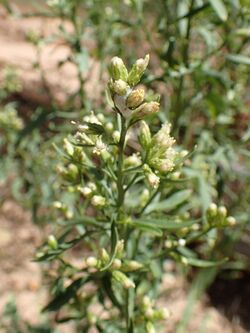Biology:Baccharis salicina
| Baccharis salicina | |
|---|---|

| |
| Scientific classification | |
| Kingdom: | Plantae |
| Clade: | Tracheophytes |
| Clade: | Angiosperms |
| Clade: | Eudicots |
| Clade: | Asterids |
| Order: | Asterales |
| Family: | Asteraceae |
| Genus: | Baccharis |
| Species: | B. salicina
|
| Binomial name | |
| Baccharis salicina Torr. & Gray
| |
| Synonyms[1] | |
|
Synonymy
| |
Baccharis salicina is a species of plant in the family Asteraceae. Common names include willow baccharis,[2] and Great Plains false willow.[3] It is a shrub found in North America where it grows in mildly saline areas.
Description
Baccharis salicina is a shrub producing erect, branching stems approaching 4 metres (13 ft) in maximum height. The thick leaves are oblong to oval in shape and sometimes have roughly toothed edges. They may be up to 7 centimetres (2.8 in) long. The shrub is dioecious, with male and female plants producing flower heads of different types. The head is enclosed in a layer of phyllaries and the female flowers yield fruits, each an achene with a white pappus about a centimeter long.[3]
The earliest name for the species is Baccharis salicifolia Nutt., coined in 1840.[4] This name, however, had previously been used for some South American material,[5] so the North American plants needed to be renamed as Baccharis salicina.[6]
Distribution and habitat
The plant is native to the United States (southern Great Plains region and Southwestern United States; states of California , Nevada, Arizona, Colorado, Kansas , New Mexico, Oklahoma, Texas , and Utah[7][8] and northern Mexico (Baja California, Chihuahua, Coahuila, Nuevo León, Durango, Sonora).[3][9]
The plant grows on open sandy flood plains, most commonly in mildly saline areas.[10]
References
- ↑ The Plant List, Baccharis salicina Torr. & A.Gray
- ↑ "Willow Baccharis (Baccharis salicina)". Chihuahan Desert Plants. Archived from the original on 15 June 2010. https://web.archive.org/web/20100615175229/http://museum2.utep.edu/chih/gardens/plants/baccsali.htm. Retrieved 9 September 2012.
- ↑ 3.0 3.1 3.2 Flora of North America, Willow-baccharis, Great Plains false willow, Baccharis salicina Torrey & A. Gray
- ↑ Nuttall, Thomas 1840. Transactions of the American Philosophical Society, new series 7: 337
- ↑ Persoon, Christiaan Hendrik 1807. Synopsis Plantarum 2: 425
- ↑ Torrey, John & Asa Gray. 1842. flora of North America :containing abridged descriptions of all the known indigenous and naturalized plants growing north of Mexico, arranged according to the natural system 2(2): 258-259
- ↑ United States Department of Agriculture plants profile
- ↑ Biota of North America Program 2014 county distribution map
- ↑ Tropicos, specimen listing for Baccharis salicina Torr. & A. Gray
- ↑ "Oklahoma Biological Survey, Baccharis salicina Torr. & Gray". http://www.biosurvey.ou.edu/shrub/basa.htm.
Wikidata ☰ Q4838647 entry
 |

